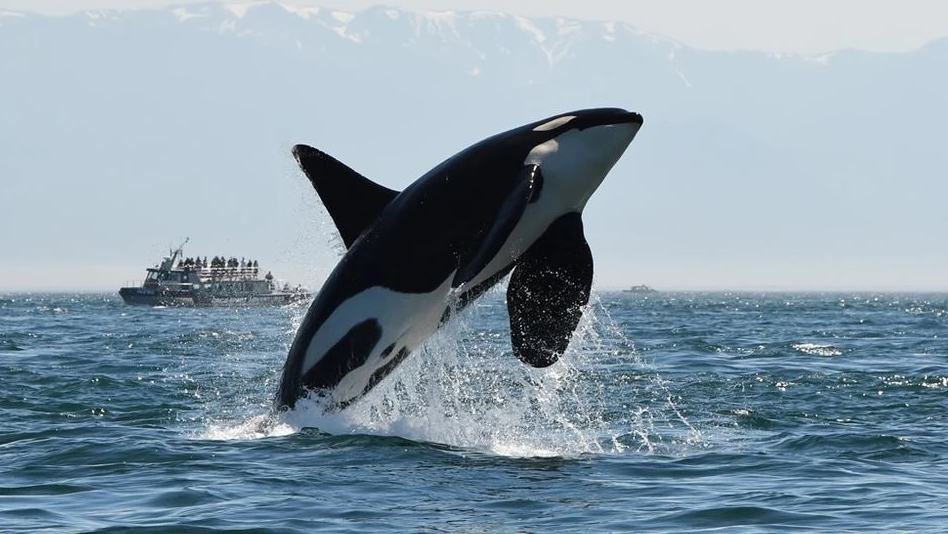Endangered orcas suffered calorie deficit in recent years: UBC study
 Southern resident orca K25 is seen in mid-breach. Researchers now fear the killer whale is one of three endangered southern residents that have died. (Dave Ellifrit/Center for Whale Research)
Southern resident orca K25 is seen in mid-breach. Researchers now fear the killer whale is one of three endangered southern residents that have died. (Dave Ellifrit/Center for Whale Research)
A new study released by the University of British Columbia found that southern resident killer whales (SRKW) did not have enough to eat in recent years, which correlates to higher mortality and lower fertility rates.
The study tracked the critically endangered SRKWs over the past 40 years, and found that they did not get enough to eat in six of those 40 years – three of which occurred in the most recent years of the study, from 2018 to 2020.
On average, adult killer whales were about 28,716 calories short in their diet in the six years that deficits were recorded, or about 17 per cent of their average daily energy requirements, according to the study.
"With the southern resident population at such a low level, there’s a sense of urgency to this kind of research," said lead author Fanny Couture, a doctoral student at the Institute for the Oceans and Fisheries (IOF) and Ocean Wise, in a release Monday.
As of October 2021, the SRKW population numbered about 73 orcas.
CHINOOK SALMON DECLINES
The southern residents feed mostly on Chinook salmon, and when Chinook salmon populations declined, the orcas were affected, the study found.
"The years where southern residents were in an energy deficit are also years where other studies report lower population growth rate and higher mortality rates for the killer whales," said Dr. Villy Christensen, professor at IOF and co-author of the study.
Researchers are uncertain why Chinook salmon populations are declining, though there are several factors, including climate change, disease, and predation by other animals.
Commercial fishing also plays a role, though researchers say Chinook salmon harvesting was reduced in Canada in the late 1990s, and that salmon declines have continued over the past two decades.
"Those declines have continued despite severe fisheries reductions, and one very likely candidate for causing them is the massive increase in abundance of Steller sea lions since the mid-1980s; those sea lions now consume more fish than all the B.C. commercial fisheries for all species, combined," said Dr. Carl Walters, senior author of the study and retired professor at IOF.
MORE FISHING RESTRICTIONS MAY BE NEEDED
Researchers found that when Chinook salmon populations were particularly low, southern resident killer whales would feed on other types of salmon, such as chum. However, their energy deficits would still occur.
Study co-authors say more restrictions on Chinook salmon fishing may still be required to protect both the fish and the orcas, as well as further research into underwater noise pollution.
"Both killer whales and Chinook salmon, the southern resident’s main prey, are important, iconic species for the west coast of Canada," said Couture
"Studying what is happening to the population may help offer solutions, both for the southern residents and potentially other killer whale populations in the future."
CTVNews.ca Top Stories

Canada's response to Trump deportation plan a key focus of revived cabinet committee
U.S. president-elect Donald Trump's promise to launch a mass deportation of millions of undocumented people has the Canadian government looking at its own border.
Who should lead the Liberals? 'None of the above,' poll finds
As questions loom over Prime Minister Justin Trudeau’s leadership, a new Nanos Research poll commissioned for CTV News says a quarter of Canadians say none of the potential candidates appeal to them.
New technology solves mystery of late First World War soldier's flower sent home to Canada
In 1916, Harold Wrong plucked a flower from the fields of Somme, France and tucked it into a letter he mailed home to Toronto. For decades, the type of flower sent remained a mystery.
U.S. election maps: How did 2024 compare to 2020 and 2016?
Though two states have yet to be officially called, the U.S. election map has mostly been settled. How does it compare with the previous two elections?
Canada rent report: What landlords are asking tenants to pay
Average asking rents declined nationally on a year-over-year basis for the first time in more than three years in October, said a report out Thursday.
N.S. school 'deeply sorry' for asking service members not to wear uniforms at Remembrance Day ceremony
An elementary school in the Halifax area has backed away from a request that service members not wear uniforms to the school's Remembrance Day ceremony.
Remembrance Day: What's open and closed in Canada?
While banks and post offices will be closed nationwide on Remembrance Day, shops and businesses could be open depending on where you live in Canada.
Judicial recount for Surrey-Guildford confirms B.C. NDP's majority
The B.C. New Democrats have a majority government of 47 seats after a judicial recount in the riding of Surrey-Guildford gave the party's candidate 22 more votes than the provincial Conservatives.
48,584 space heaters recalled in Canada after burn injury in U.S.
Health Canada has announced a recall for electric space heaters over potential fire and burn risks, a notice published Thursday reads.


































